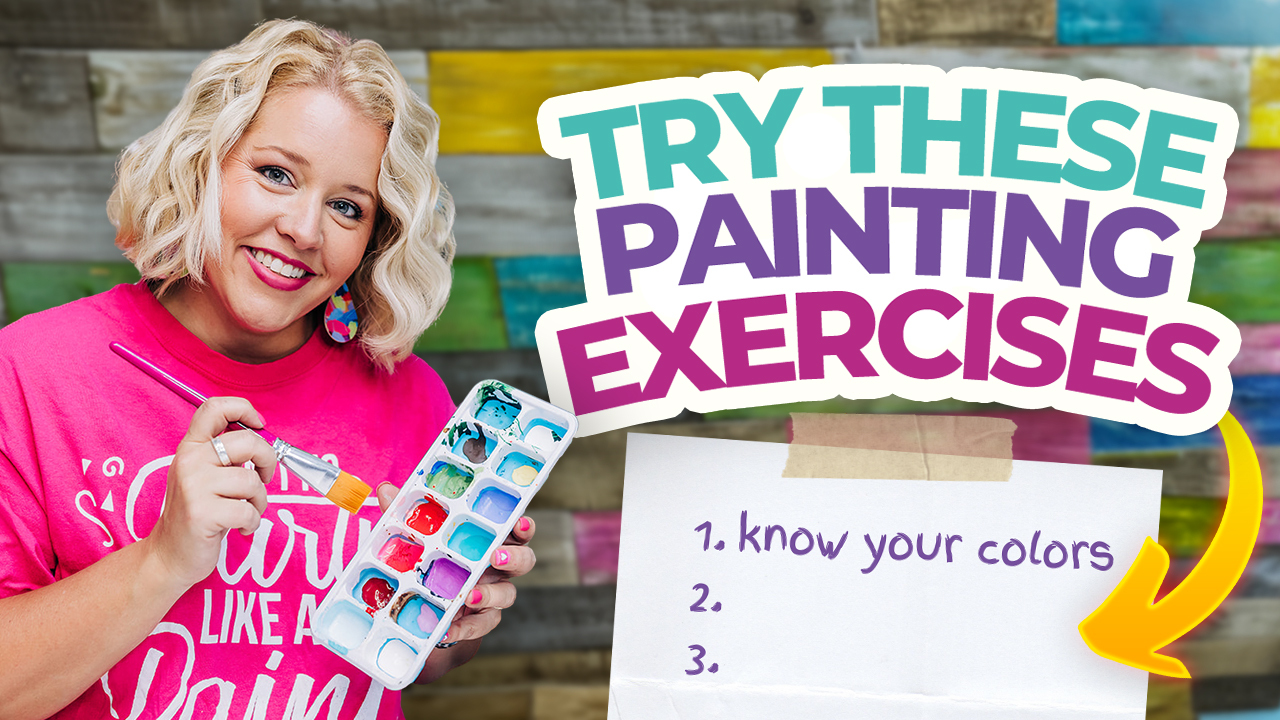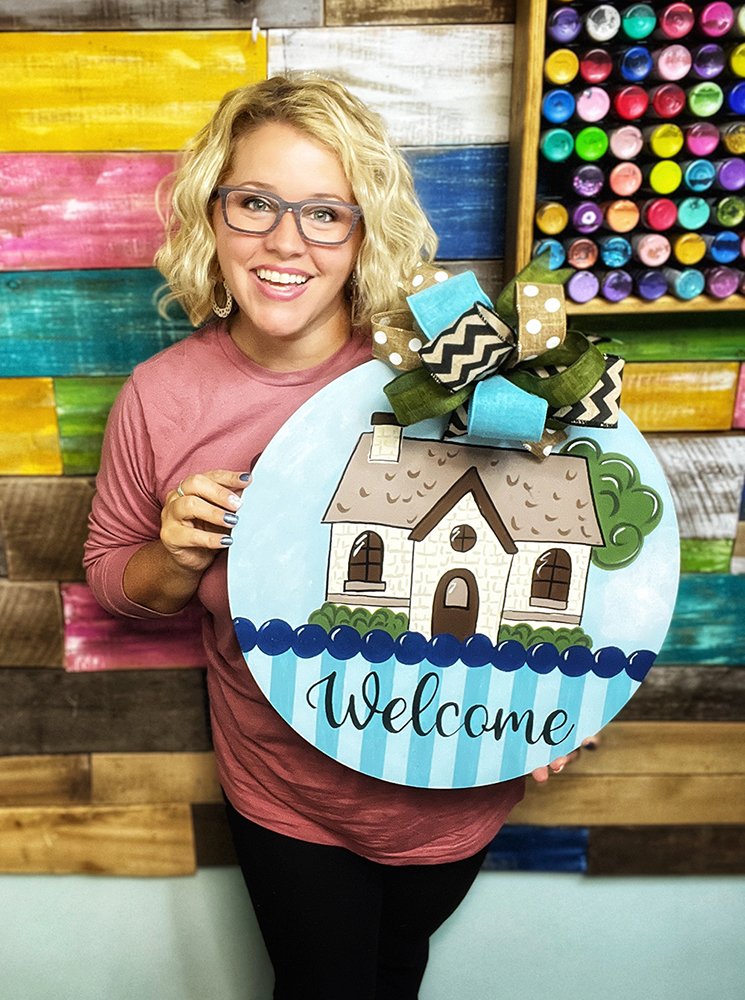Some of the links shared in this blog post are affiliate links. This means I make a small commission when you purchase through these links at no extra cost to you. All opinions and reviews shown are honest and my own. Thank you for supporting my small business!
I’ve been painting door hangers for about 10 years now, and let me tell you — I’ve made pretty much every mistake in the book. But as Bob Ross would say, there are “no mistakes, just happy accidents.”
And I am sure glad I made those mistakes, because they’re what helped me become better at painting door hangers!
So today, I want to share some of my favorite door hanger tips for beginners. These are what helped me grow from a nervous newbie to a confident painter. Trust me on this one: every project teaches you something new, especially when it pushes you outside your comfort zone!
Door Hanger Tip #1: Use High-Quality Paint (Yes, It Makes a Difference!)
When I first started out, I was working with whatever paints I could get my hands on — hand-me-downs, donated supplies from former crafters, and bargain finds from Walmart and the Dollar Store.
It was budget-friendly but not the best for my door hangers.
I discovered that cheaper paints often have unpredictable thickness and color-matching issues. One time, I left some paints in my car between paint parties (big mistake!), and they got so thin they were practically water. I definitely learned a lesson from that!
But really, it wasn’t until I switched to Deco Art Americana paints that I realized how much of a difference quality paint makes. I’ve stuck with them for quite a while now, and they’re the paint I recommend to anyone who will listen!
Door Hanger Tip #2: How to Balance Your Color Palette
I used to be all about those bold, bright colors. Everything I painted looked like a psychedelic neon sign because I’d use every vibrant shade I could find! Now I know the secret to using bright colors is balance. You’ve gotta have a few softer tones to keep it from feeling overwhelming.
Pick a couple of bold colors to be your focal point, then pair them with softer tones to create a design that’s pleasing to the eye! This still allows you to use those bright, fun colors you love without the overwhelm.
Not sure what colors work together? Look for inspiration in nature, like sunset colors or flower combinations. Even your favorite t-shirt graphic can be a great color palette reference!
Door Hanger Tip #3: How to Create Depth with Details
Here’s one of my favorite tricks for adding interest to your background: use two shades of the same color. For example, if you’re doing polka dots in pink, paint your background in your base pink shade, then mix a little white into that same pink for your dots.
This creates subtle detail without competing with your main design (and helps those details pop!).
If you’re going for a weathered or distressed look, grab a chip brush (you can find those at any hardware store), and a tiny bit of paint. This type of brush will help you create some texture.
I love using this technique for barn wood effects! You can start with a red background (or whatever color you want your barn to be), then add streaks of deeper red or brown, and finish with a touch of white or light gray for dimension.
Door Hanger Tip #4: How to Get the Perfect Polka Dots
The key to great polka dots is making them look like a seamless pattern that extends beyond the edges, rather than “floating” in the middle of the door hanger.
To do this, I have what I like to call my triangle trick: place your first dot, then imagine a triangle and place two more dots at the other corners. Keep building triangles from there, and don’t be afraid to let dots go off the edge of your design. This creates a natural-looking pattern every time!
Door Hanger Tip #5: How to Get Straighter Lines & Avoid Paint Ridges
Ever heard of paint ridges? That’s what happens when paint builds up along the edge of your design, adding unwanted texture. To avoid this, try dabbing off excess paint in the middle of your painting area before working on the edges.
Think back to elementary school — remember how you’d color around the edges first, then fill in the middle? With painting, we want to do the opposite!
And if you want straighter, smoother lines, move your whole body, not just your hand. Turn your door hanger so the line you’re painting comes toward you, then lean forward to start the line.
Then, lean back to pull it toward you. This uses your core muscles for stability instead of relying on your wrist and arm alone (which leads to shaky lines!).
Door Hanger Tip #6: How to Plan Your Layers
Before you start painting, think about your layers. You want to paint the entire background first. Then, work from the biggest area to the smallest.
For example, if your design has stripes in the background and small flowers, do the stripes, then the flowers. Then, you can do the smaller details, like hand lettering, last.
Don’t forget coverage — light colors won’t paint well over dark ones. For example, yellow paint isn’t going to show up well over navy blue! Either paint around areas that will be light colors, or plan to add a white base coat in those spots.
Door Hanger Tip #7: Trust the Process
I tell my students inside the Painter’s Clubhouse this all the time…trust the process! If you’re following along with a tutorial and getting frustrated halfway through, take a break and come back to it later.
The creative process isn’t always perfect, and that’s okay! Everything you paint helps you improve. Besides, perfection isn’t the goal — having fun is!
Get More Tips Inside the Painter’s Clubhouse
If you want some more support and guidance as you paint your door hangers, consider joining us inside the Painter’s Clubhouse!
This monthly door hanger painting membership offers additional resources for both beginners and experienced crafters alike! Inside the Clubhouse, you’ll gain access to a supportive community, a vast library of video tutorials, and new templates every month (and so much more)!
Are you ready to take your door hangers to the next level? Come join us!
Learn more about the Painter’s Clubhouse here.



0 Comments